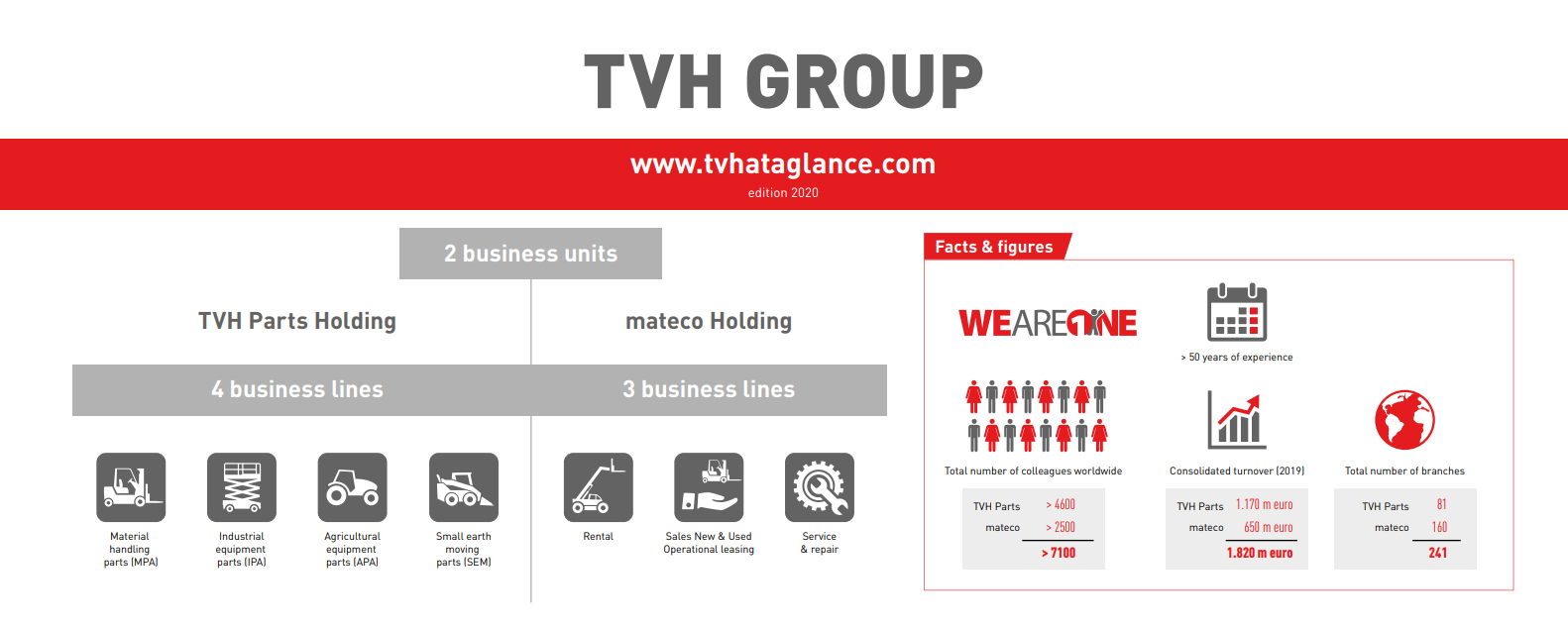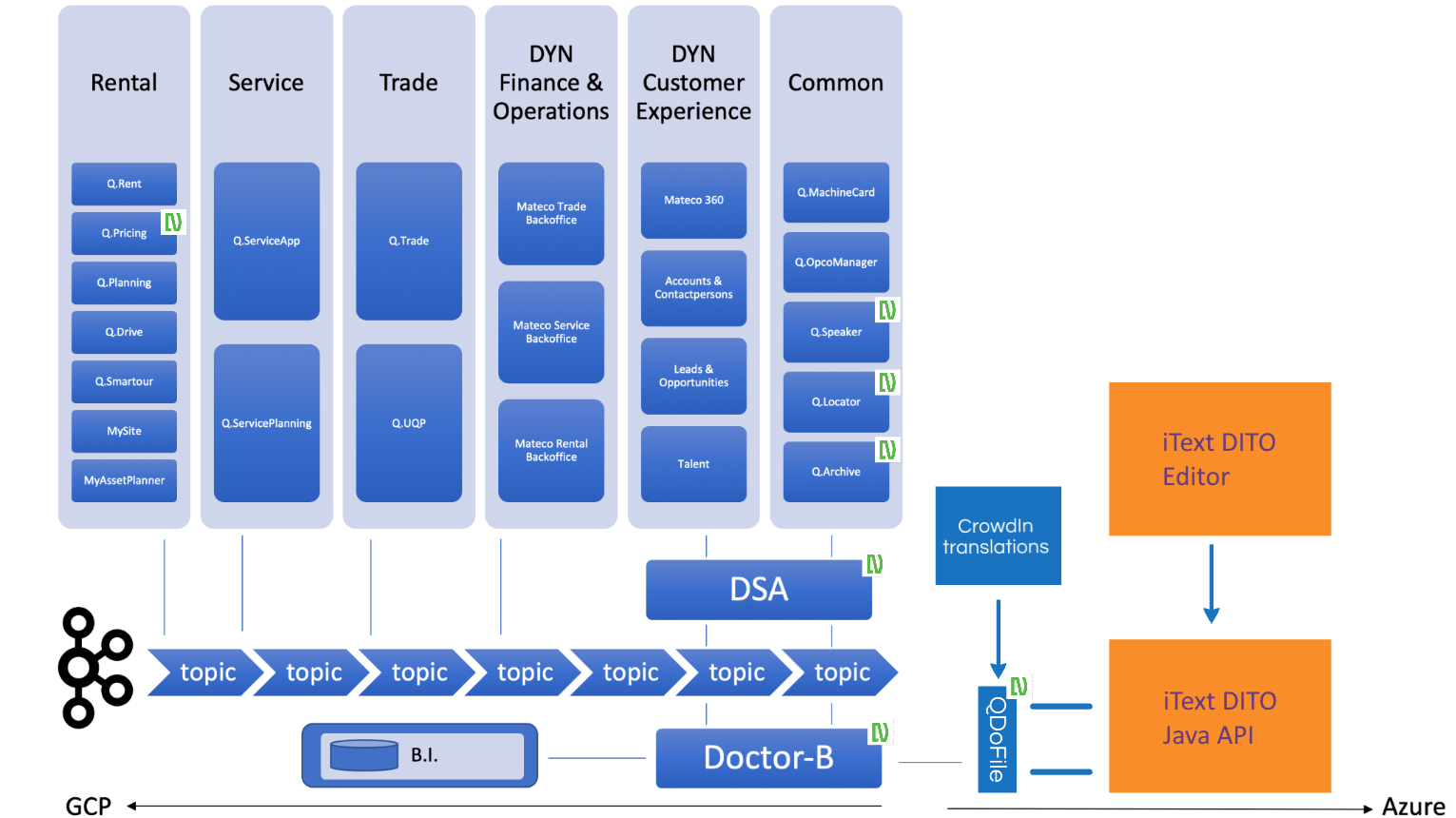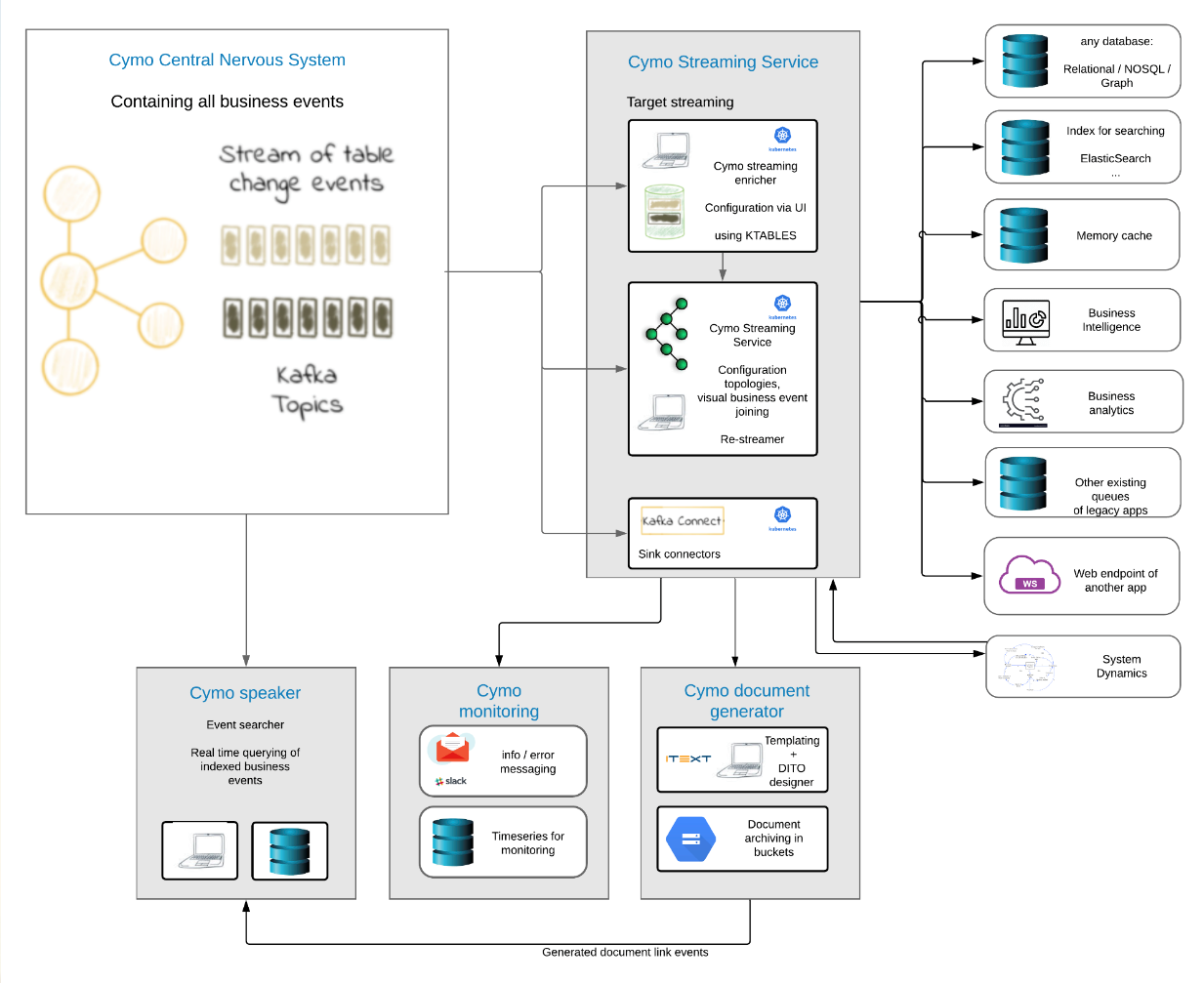iText DITO – Revolutionizing mateco (TVH Group)'s working platform hire processes
Learn how the mateco Group is using iText DITO as part of a revolutionary new streaming architecture to efficiently update and maintain their height equipment hire processes.

Background
As one of the leading suppliers for renting working platforms, the mateco Group has a fleet of rental equipment which comprises over 12,000 working platforms in more than 700 different designs, totaling around 40,000 machines in the fleet. With over 150 locations in Europe, Mexico, Panama and Chile and more than 80 partners around the world, the company has expanded from small beginnings with the hiring of truck-mounted working platforms, to become a worldwide operation.
Originally established in Stuttgart, Germany in 1973, mateco AG was purchased by the TVH Group in 2012 and renamed as mateco GmBH. Although within Belgium the TVH name is more common, the mateco brand is used in other parts of the world.
 As can be seen in the above image, the TVH Group consists of two business units: TVH Parts Holding and mateco Holding. Comprising mateco Holding are three business lines, covering equipment hire and rental, sales of new and used equipment, and service and repair.
As can be seen in the above image, the TVH Group consists of two business units: TVH Parts Holding and mateco Holding. Comprising mateco Holding are three business lines, covering equipment hire and rental, sales of new and used equipment, and service and repair.
For the organization’s enterprise resource planning (ERP), mateco uses the Microsoft Dynamics platform for various tasks like financial management, supply chain, operations etc. As part of their business analytics, they wanted to use system dynamics methodology, which is a way to understand the behavior of complex systems over time.
To develop an intelligent solution capable of integrating mateco’s business processes, mateco joined forces with Debreuck-Neirynck. Debreuck-Neirynck is a software development company which specializes in building software solutions for the food and logistics sector. As part of the established and extensive Cronos Group, they have access to the largest IT ecosystem in Belgium and are experts in the field of streaming architecture.
We spoke with Wim Debreuck, a managing partner of Debreuck-Neirynck, and an integration architect for Q.One, the IT department within the TVH/mateco Group. The Q.One team consists of 150 IT professionals, who developed a new platform to communicate with the ERP system with custom-built apps using streaming architecture. He told us about the power and value offered by streaming architecture.
“Streaming architecture is a real evolution, a true game changer, something which transforms the way of integrating things for good” he says. “If you have streaming architecture, you have a detailed timeline of events that happened in your business; when a contract was created, a payment was completed, and so on. Once you have those events, you can then do behavior analysis, you can see what the timing is between something that you provide and when something gets paid, or when something needs to be shipped, including the delays and bottlenecks that arise.”
The implementation of streaming architecture has a strong impact on business processes. Everything needs to be translated as business events, a way of expressing technical matters in business language. A business event message can simply include that a “contact has been created” but can contain a lot of underlying technical information. In addition, streaming architecture facilitates an easier dissolution of existing systems. Different components can be isolated, and it can be decided whether or not they can be reused.
Streaming architecture is also very distinctive compared to classic business intelligence, where data is stored in huge data lakes which must be searched to and try to make some sense of it. Instead, behavior can be analyzed while it’s happening, enabling the capture and processing of mass data in real-time.
Goals
- To replace all legacy systems with a new platform consisting of a standard ERP system and custom-built apps used by mateco’s workforce and customers
- To build and deliver a solution in a cloud-native and multi-cloud environment.
- To roll out the solution worldwide, across 15 countries.
- 85% alignment between countries to use the same processes,
- A 5% improvement in stock rotation.
- A 2% increase in efficiency each year
Challenges
Q.One initially used a different system to handle the process of PDF generation, using a connector for Microsoft Dynamics. However due to the cloud-native architecture of the Cymo architecture, and the multi-cloud approach needed to bridge between the custom apps on Google Cloud and the Dynamics ERP on Azure meant there was a technology mismatch in this part of the architecture. Workarounds were possible but led to more and more complexity when processing data for generating documents.
Q.One quickly determined that they needed a more flexible and modern PDF solution that was cloud-aware, had an API, and was able to be containerized. “We are all pretty technical people, so iText was of course known to us as a library” says Wim Debreuck. “Also, my company is a development company packed with developers, and all Java-oriented. In fact, I think for all technical people iText is known as a very good PDF library. So, it was natural for us to look at iText for this task.”
Offered solution
Wim Debreuck contacted iText to see how we could help. After discussing their use case, we suggested that iText DITO would be the perfect solution for not just the PDF generation, but also to handle the designing of templates required for the various documents used by mateco Holdings.
iText DITO is a low-code template-based PDF document generator. By simplifying the process of creating and maintaining data-driven PDF templates, it not only reduces the time and cost of document automation projects, but also reduces developer workload by empowering business users to design and maintain their own templates.
Template designers can use the dynamic data binding to link JSON data samples to templates using placeholders in the iText DITO Editor. Conditional logic and formatting can also be used to show or hide content based on your data, and CSS can be used to apply consistent styling to documents.
iText DITO consists of a WYSIWYG browser-based template designer and a PDF generation API built to handle enterprise-level requirements and volumes. The API is available as a native Java application or a Docker container for convenient deployment, easy scaling and language-agnostic interfacing.
Q.One quickly found that iText DITO was indeed the ideal solution. Besides its template design and PDF generation capabilities, a particularly important factor was its low overhead compared to other options. “The fact that iText DITO has a browser-based editor was definitely a benefit to us” says Wim. “The competition all has fat clients, something that needs to install, has a footprint etc. At mateco we have a mantra that we call “zero touch, zero footprint. In everything we do, we need to verify that the device we need to do our job is replaceable.”
|
The fact that iText DITO has a browser-based editor was definitely a benefit to us. The competition all have fat clients, something that needs to install, has a footprint etc. At mateco we have a mantra that we call “zero touch, zero footprint. In everything we do, we need to verify that the device we need to do our job is replaceable. |
 |
Wim Debreuck, Q.One Integration Architect |
To help achieve their deadline for the initial rollout, Q.One asked if iText could assist with the transfer of their existing templates to iText DITO templates. To achieve this goal, Erwin Buggenhout, the iText DITO Product Manager took on a temporary dual role as the Project Manager for this mission. He worked closely with our in-house template development experts to reproduce the templates Q-One needed for initial deployment, enabling Q.One to concentrate on training up their own template designers so that they could continue the project.
This proved such a success that iText now also offers this service to other companies looking to integrate iText DITO into new or existing workflows, under the banner of iText DITO Professional Services. If you’re interested in learning more, simply contact us with your questions.
Feedback from their in-house template designers on the iText DITO Editor has been very positive, with praise for the clear UI making it easy to create headers and footers, and a very good structure for implementing different data binds in a single cell.
How it works
Q.One’s streaming architecture is a brand-new platform connecting a Microsoft Dynamics ERP system with over 20 custom-built apps used by mateco’s workforce and customers. The streaming architecture uses Apache Kafka, an open-source distributed event streaming platform used by thousands of companies for high-performance data pipelines, streaming analytics, data integration, and mission-critical applications.
|
I think for all technical people iText is known as a very good PDF library. So, it was natural for us to look at iText for this task. |
 |
Wim Debreuck, Q.One Integration Architect |
The overall integration between all components is achieved by the use of Kafka and streaming architecture, bridging a multi-cloud structure of Google Cloud used by the custom apps, and the Dynamics ERP on Azure.
As illustrated in the architecture diagram below, the vertical columns show the various business units, Rental, Service, Trade etc. Encapsulated in each business unit are the applications developed to handle the tasks required by each unit, whether its machinery rental, pricing, applications used by drivers who deliver the equipment and so on.

Each of these applications feed data into the Kafka-based streaming integration (shown across the bottom of the diagram) and the Dynamic Streaming Adaptor (DSA)to fetch and capture the events generated by the various units. There is also the Business Intelligence component (BI) and finally Doctor-B which joins and processes the JSON data from the integration layer and provides that to QDoFile, which forms the bridge between the streaming architecture and the iText DITO components.
The QDoFile component takes the data intended for generating a document, and combined with translations obtained using CrowdIn, then passes it to the iText DITO SDK which then combines it with the required template to generate the document.
Result
The system is in the process of being rolled out worldwide, across the 15 countries in which mateco operates. During 2021 it is projected that around 1.2 million documents will be generated, with a goal of 6 million documents once the rollout is complete. The Q.One squad has also been focusing on creating specific functionalities and making the platform much more intelligent.
Introducing Cymo, in partnership with iText
In addition, a new company has been created to commercialize the platform for other market segments, Headed by Wim Debreuck and Kris van Vlaenderen, who is a Solutions Architect at Q.One, Cymo aims to use their expertise in streaming architecture so that other organizations can benefit. iText is partnering with Cymo to offer iText DITO document generation for any app using streaming architecture integration.
“It was always the intention to commercialize this technology” says Wim Debreuck. “We want to give other companies access to streaming architecture integration. Not by pumping €30 million a year into a project, but to instead give them a head start by giving them a platform. We can reuse the platform we built for mateco to give other companies fast access to the same value, but without starting from scratch.”
The Cymo platform

Part of the Cymo platform is of course iText DITO. “Cymo opens the gates for ERP systems to let's say, step out of their normal internal PDF generation, and instead use iText DITO. They can access and use the data from the ERP system, but also data that is outside of the ERP system since it is linked by the streaming architecture.”
Webinar: High-volume PDF creation within a streaming microservice architecture
Together with Cymo, we held a webinar to take a closer look at how our partnership can offer iText DITO document generation for any app using streaming architecture integration.. Watch the video to learn how you can unburden your developers, and step away from fat clients with huge footprints or fragmented legacy systems.
About the mateco Group
The mateco Group is one of the leading suppliers for renting working platforms. With a fleet of rental equipment currently comprising over 12,000 working platforms in more than 700 different designs. Spread over 150 locations in Europe, Panama and Chile and with over 80 partners around the world, they pursue a clear goal: to supply the best height access technology for their customers. This has made them the industry professionals for over 40 years.
Originally established as mateco AG in Stuttgart, Germany, the company was purchased by the TVH Group in 2012. It was incorporated into its mateco Holding business unit, and the mateco brand name continues to be used for the TVH Group's worldwide operations.